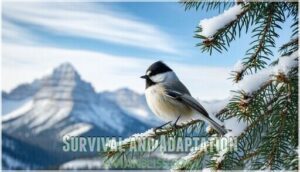This site is supported by our readers. We may earn a commission, at no cost to you, if you purchase through links.

These hardy birds thrive in coniferous forests across western North America, from sea level to treeline at 12,000 feet.
They’re smaller than a sparrow but packed with personality, flitting through pine and fir branches while calling out their raspy "chick-a-dee-dee-dee."
Mountain chickadees eat insects, seeds, and berries, often hanging upside down to reach food on branch tips.
They’re year-round residents who cache thousands of seeds for winter survival, and their remarkable memory and survival strategies reveal fascinating secrets about mountain life.
Table Of Contents
- Key Takeaways
- Mountain Chickadee Description
- Habitat and Distribution
- Diet and Feeding Behavior
- Nesting and Reproduction
- Survival and Adaptation
- Attracting Mountain Chickadees
- Conservation and Fun Facts
- Frequently Asked Questions (FAQs)
- Where do chickadees live?
- What is a mountain chickadee?
- What does a mountain chickadee look like?
- Do mountain chickadees live together?
- Why is the mountain chickadee called Poecile?
- Do mountain chickadees live in Highland Pines?
- What is the difference between a chickadee and a mountain chickadee?
- Are mountain chickadees rare?
- Do mountain chickadees have good memories?
- What do mountain chickadees eat in winter?
- Conclusion
Key Takeaways
- You’ll instantly recognize mountain chickadees by their distinctive white eyebrow stripe above a black cap—no other chickadee has this marking, making identification easy in western coniferous forests.
- These hardy birds thrive at elevations between 3,000-12,000 feet across western North America, from British Columbia to Texas, preferring mature pine, fir, and spruce forests year-round.
- You’ll be amazed by their survival skills—they cache up to 80,000 seeds annually and remember thousands of hiding spots with GPS-like accuracy, essential for surviving harsh mountain winters.
- You can attract them to your backyard with black oil sunflower seeds and suet feeders placed near trees, where they’ll demonstrate their acrobatic feeding style and distinctive raspy "chick-a-dee-dee-dee" calls.
Mountain Chickadee Description
You’ll recognize mountain chickadees by their distinctive white eyebrow stripe that sets them apart from their black-capped cousins.
These small songbirds sport black caps, white cheeks, and grayish-brown backs, measuring just 4.5 to 5 inches long with sharp beaks perfect for cracking seeds.
Feathered acrobats that turn mountain winters into survival masterclasses, one cached seed at a time.
Physical Characteristics
Mountain chickadees are tiny powerhouses you’ll recognize instantly by their distinctive features.
These sparrow-sized birds sport a striking black cap and pristine white cheeks that make identification straightforward in coniferous forests.
Here are their key physical traits:
- Head Pattern: Bold black cap with white eyebrow stripe above bright white cheeks
- Size and Shape: Compact 4.5-inch body with proportionally large head and long, narrow tail
- Beak Shape: Small, pointed bill perfect for cracking seeds and catching insects
- Color Pattern: Gray-brown back, pale belly, with distinctive black and white facial markings
Regional Variations
Across western North America, you’ll notice subtle regional differences in mountain chickadee appearance.
Bill shape varies slightly between populations, with some having more pointed beaks than others.
Flank color shows geographic morphs too – birds in the Rocky Mountains often display warmer buff tones, while Pacific Coast subspecies lean toward cooler gray shades.
These regional plumage variations help Poecile gambeli adapt to different environments, which is a key factor in their ability to thrive in various environments with distinct plumage variations.
Size and Weight
These sparrow-sized birds measure just 4.3 to 5.5 inches in length, with their body mass weighing only 0.4 ounces.
Weighing less than half an ounce, these tiny mountain survivors pack incredible resilience into their sparrow-sized frames.
Their wing length spans 6 to 8 inches, while their distinctive large head shape and small beak size make them easy to identify.
Despite their feather weight being minimal, mountain chickadees pack remarkable survival skills into their compact frames for harsh mountain living.
Accurate bird measurements require a reliable bird weight scale to guarantee precise data collection for harsh mountain living.
Habitat and Distribution
Mountain chickadees make their homes in the coniferous forests of western North America, from British Columbia down to Texas.
You’ll find these hardy birds at elevations between 3,000 and 12,000 feet, thriving in the pine, fir, and spruce forests of the Rocky Mountains, Sierra Nevada, and Cascade ranges.
Preferred Forests
You’ll find these chickadees thriving in mature coniferous forests dominated by pine, fir, and spruce trees across mountainous regions.
They prefer mixed conifer forests with at least 50% canopy cover and complex vertical structure.
Old-growth stands with standing dead trees support higher densities than young forests, as fallen logs and snags provide essential nesting cavities for successful breeding.
Elevation Range
You’ll find these hardy birds thriving in elevation zones between 3,000 and 12,000 feet above sea level.
While they prefer high-altitude forests and mountainous regions, they’re most comfortable in that sweet spot of 6,500 to 10,000 feet where coniferous forests and subalpine forests flourish.
These elevations provide the perfect blend of shelter and food sources they need.
Geographic Range
You’ll spot these hardy birds throughout western North America’s mountain ecosystems.
Their range stretches from British Columbia down to Texas, following the major mountain chains. Here’s where Mountain Chickadees call home:
- Rocky Mountains – From Canada through Colorado and New Mexico
- Sierra Nevada – California’s eastern mountain spine
- Cascade Range – Washington and Oregon’s volcanic peaks
- Great Basin – Nevada’s scattered mountain ranges
These western territories offer the high-altitude forests and montane woodlands they need to thrive year-round.
Diet and Feeding Behavior
Mountain chickadees are opportunistic feeders that adapt their diet based on seasonal availability.
You’ll find them switching between protein-rich insects during breeding season and energy-dense seeds and berries in winter.
Their remarkable memory allows them to cache thousands of food items for survival.
Primary Food Sources
Mountain chickadees rely on diverse nutrient sources throughout the year.
During summer, insect populations provide essential protein – caterpillars make up 60% of their diet during nesting season.
They target beetles, spiders, ants, and aphids for growing chicks.
Winter brings a shift to seeds and nuts from ponderosa pine, lodgepole pine, and fir trees.
Berry consumption supplements their diet, while black oil sunflower seeds dominate feeding opportunities in coniferous forests where these adaptable birds thrive.
Foraging Adaptability
You’ll watch these clever birds shift gears throughout the seasons with remarkable ease.
Their omnivorous diet lets them switch from hunting caterpillars and beetles in summer to foraging for conifer seeds and berries when snow blankets high-altitude forests.
This adaptive eating strategy helps them thrive where other species struggle, making the most of whatever food sources their mountain home provides.
Food Caching
You’ll be amazed by their memory capacity – these birds cache up to 80,000 seeds annually in bark crevices and tree holes.
Their caching behavior involves strategic food hiding throughout their territory. Each seed storage location gets mentally mapped for winter survival.
During cache retrieval, they remember thousands of spots with pinpoint accuracy. This omnivorous diet strategy supports seed dispersal while ensuring food caching success through harsh mountain winters.
The birds’ ability to adapt to different environments is influenced by their unique ground feeding behaviors, which is a key factor in their winter survival.
Nesting and Reproduction
Mountain chickadees are cavity nesters that carefully select their breeding sites in spring.
You’ll find their nests tucked into tree holes, abandoned woodpecker cavities, or nest boxes between 5 and 25 feet above ground.
Nest Placement
Finding the perfect nest site is vital for mountain chickadees’ success.
These cavity nesting birds prefer tree cavities, especially abandoned woodpecker holes located 5-25 feet above ground.
They’ll also use nest boxes if available.
Natural cavities in dead trees or stumps work well too.
The chickadee nest site selection focuses on secure, sheltered spots that protect against predators and weather.
Understanding key factors like nest site selection is essential for appreciating the complexity of their breeding habits.
Nest Description
Once you’ve located the perfect tree cavity, you’ll discover these cavity nesters create remarkably cozy homes.
The female builds a cup-shaped nest using specific materials:
- Soft bark fibers form the foundation
- Moss provides insulation and structure
- Animal hair adds warmth and comfort
- Feathers create a soft lining
- Plant down fills gaps for weather protection
These nest materials create a snug retreat inside tree cavities or nest boxes, typically positioned 5-25 feet high.
Eggs and Incubation
Female mountain chickadees typically lay five to nine white eggs with reddish-brown speckles in their chickadee nest.
The incubation period lasts about fourteen days, with only females handling this duty.
During this time, males provide food while females maintain ideal nest temperature.
This clutch size and fledging period of roughly three weeks guarantees successful reproduction in harsh mountain environments, ensuring successful reproduction.
Survival and Adaptation
Mountain chickadees have mastered survival in some of North America’s harshest environments through remarkable adaptations.
You’ll find these resilient birds thriving at elevations up to 12,000 feet, where their specialized feathers and incredible memory skills help them endure brutal mountain winters.
Harsh Winter Survival
When winter hits high-altitude forests, you’ll find mountain chickadees using remarkable cold weather adaptations.
These resilient birds enter torpor, dropping their body temperature by 8°C to conserve energy during harsh environments.
Winter foraging becomes critical as food scarcity increases.
Their survival strategies include enhanced shivering thermogenesis and communal roosting in dense conifers, reducing individual energy demands while weathering subfreezing conditions.
Insulated Feathers
Mountain chickadees boast remarkable feather structure that keeps them warm in brutal mountain conditions.
Their down feathers trap air close to their bodies, creating thermal insulation that works like a natural sleeping bag.
You’ll notice these birds fluff up during cold snaps, maximizing their cold adaptation systems.
- Dual-layer feather system: Dense down underneath with waterproof outer feathers
- Air pocket creation: Fluffed feathers trap warm air for thermal insulation
- Preening behavior: Regular feather maintenance keeps insulation effective
- Seasonal adjustments: Extra down grows before winter in high-altitude forests
Food Storage
You’ll be amazed by their food caching abilities. These birds stash up to 80,000 seeds annually in bark crevices and tree holes, using remarkable spatial memory for winter storage retrieval.
Their cache strategies include hiding suet, sunflower seeds, and insects across their territory. This caching behavior makes survival possible during harsh mountain winters when fresh food becomes scarce.
To maintain seed freshness, understanding proper seed storage methods is vital to support their natural caching habits and ensure winter storage retrieval is effective, making survival possible.
Attracting Mountain Chickadees
You can easily attract mountain chickadees to your backyard by offering their favorite foods at well-positioned feeders.
These acrobatic birds enthusiastically visit feeders stocked with black oil sunflower seeds, suet, and peanuts.
Backyard Feeders
Setting up bird feeders transforms your backyard into a chickadee habitat paradise.
These mountain visitors approach feeders one at a time, demonstrating remarkable feeder etiquette.
Proper feeder placement near trees provides quick escape routes while ensuring excellent bird watching opportunities.
Regular feeder maintenance keeps your backyard birding station clean and attractive.
Winter supplements become especially vital when natural food sources diminish in their high-elevation homes.
Using the right bird feeder types can substantially enhance the attractiveness of your backyard to mountain chickadees, creating a backyard birding station and requiring regular feeder maintenance.
Seed Preferences
Once you’ve got feeders up, the real magic happens with your seed choices.
Mountain chickadees show strong preferences that’ll keep them coming back.
- Black oil sunflower seeds – their absolute favorite for high fat content and easy cracking
- Conifer seeds – mimics their natural winter diet from pine and spruce trees
- Mixed bird seeds – provides variety but they’ll pick out preferred types first
These birds rarely eat at the feeder itself. Instead, they grab one seed, fly to nearby cover, and either eat it immediately or stash it for later.
This caching behavior means you’ll see constant activity as they build their winter food stores.
Understanding their natural food sources is key to attracting them effectively.
Suet and Peanut Feeders
Beyond sunflower seeds, you’ll want to offer suet and peanut feeders for these mountain birds.
Suet recipes with insects attract them year-round, while peanut butter provides essential fats.
Strategic feeder placement near conifers supports their caching behavior.
These feeding strategies complement their natural diet, making your backyard irresistible to mountain chickadees seeking high-energy foods.
Using the right suet feeder types can substantially enhance the attractiveness of your offerings to the mountain chickadees, with a focus on natural diet and strategic feeder placement.
Conservation and Fun Facts
Mountain chickadees face few major conservation threats thanks to their stable populations and remote habitats.
These remarkable birds store up to 80,000 seeds annually and consume thousands of forest pests each year while maintaining exceptional spatial memory that rivals a GPS system.
Threats and Conservation
Mountain chickadees face serious threats from habitat loss and climate change.
Forest management practices have reduced mature conifer habitat by 15% since 2015. Wildfires cause population declines up to 22% during severe years.
Climate change shifts ranges upward while reducing snowpack and food sources. Conservation efforts include nest box programs, old-growth reserves, and forest restoration projects targeting 1,000 hectares by 2030.
Caloric Intake and Food Storage
Despite weighing just half an ounce, mountain chickadees need around 10 calories daily—equivalent to one-twentieth of an ounce of peanut butter.
These omnivorous birds excel at seed caching, storing up to 80,000 food items annually for winter foraging.
Their exceptional spatial memory enables precise food retrieval from scattered caches, meeting critical caloric needs through efficient energy storage strategies.
The mountain chickadees’ ability to survive in cold environments relies on their coniferous forest adaptations, which are crucial for their critical caloric needs and efficient energy storage.
Insect Consumption and Vocalization
These remarkable omnivorous birds from the Poecile genus consume up to 70% insects, providing natural insect control in mountain forests.
Their sophisticated call patterns and bird songs demonstrate impressive vocal learning abilities, with distinct notes for different foraging tactics and social communication.
Here are five fascinating facts about mountain chickadee insect consumption and vocalization:
- Insect Diet Powerhouse – They devour thousands of caterpillars, beetles, and spiders annually, making them excellent natural pest controllers for coniferous forests.
- Complex Bird Calls – Mountain chickadees use over 15 different vocalizations, from alarm calls to contact notes, each serving specific social functions within their flocks.
- Vocal Learning Masters – Young birds learn regional "dialects" from their parents, developing unique call variations that help identify local populations across different mountain ranges.
- Strategic Foraging Tactics – They use specific calls to coordinate group foraging, alerting flock members to rich insect patches while maintaining territorial boundaries.
- Seasonal Call Patterns – Their vocalizations change throughout the year, with breeding songs in spring shifting to simpler contact calls during winter survival mode.
Frequently Asked Questions (FAQs)
Where do chickadees live?
Chickadees live across North America in diverse habitats. You’ll find them in deciduous and coniferous forests, parks, suburban areas, and backyards with trees, adapting well to human environments.
What is a mountain chickadee?
You’ll find these small songbirds in western North America’s coniferous forests.
They’re distinguished by their black caps, white cheeks, and distinctive white eyebrow stripe that sets them apart from other chickadees.
What does a mountain chickadee look like?
Like a tiny acrobat dressed in formal wear, you’ll spot this bird’s striking black cap contrasting with bright white cheeks.
A distinctive white eyebrow stripe sets it apart from similar species.
Do mountain chickadees live together?
You’ll typically see these birds hanging out in small flocks, especially during winter months.
They’re social creatures that forage together and communicate through their distinctive calls while moving through coniferous forests.
Why is the mountain chickadee called Poecile?
You’ll discover the scientific name "Poecile" comes from Greek, meaning "variegated" or "many-colored," referring to the bird’s distinctive black, white, and gray plumage pattern that creates its varied appearance.
Do mountain chickadees live in Highland Pines?
Highland Pines sounds idyllic, but you won’t find mountain chickadees there.
These hardy birds stick to coniferous forests in western mountains, preferring pine, fir, and spruce at elevations between 3,000-10,000 feet year-round.
What is the difference between a chickadee and a mountain chickadee?
You’ll spot the key difference in that white eyebrow stripe above mountain chickadees’ eyes. Regular chickadees lack this distinctive marking, making mountain chickadees easily identifiable in western coniferous forests.
Are mountain chickadees rare?
Mountain chickadees aren’t rare – they’re actually quite common throughout western North America’s coniferous forests. You’ll find stable populations thriving in their mountain habitats from Canada to Texas year-round.
Do mountain chickadees have good memories?
Yes, mountain chickadees possess exceptional memories.
They cache up to 80,000 seeds annually and remember thousands of hiding spots with remarkable accuracy, making their spatial memory among nature’s most impressive survival tools.
What do mountain chickadees eat in winter?
During winter, you’ll find these birds shifting their diet from insects to conifer seeds, nuts, and berries. They’re clever cachers, storing thousands of seeds in bark crevices for survival.
Conclusion
Whether perched like a feathered sentinel against snowy peaks or dancing through your backyard pines, the mountain chickadee brings wild beauty to everyday moments.
You’ve learned how these remarkable birds survive harsh winters through incredible memory and food-caching skills.
Now you’re equipped to identify their distinctive white eyebrow stripe and attract them to your feeders with sunflower seeds and suet.
Watch for their acrobatic feeding displays and listen for their raspy calls—each mountain chickadee encounter connects you to the resilient spirit of high-altitude wilderness.
- https://valleyfarms.shop/blogs/news/the-busy-life-of-the-chickadee
- https://birdsbulletin.com/what-do-mountain-chickadees-eat/
- https://blog.lauraerickson.com/2023/01/four-ways-to-eat-sunflower-seed.html
- https://pmc.ncbi.nlm.nih.gov/articles/PMC9661973/
- https://blog.nature.org/2020/07/06/meet-the-mountain-chickadee/














